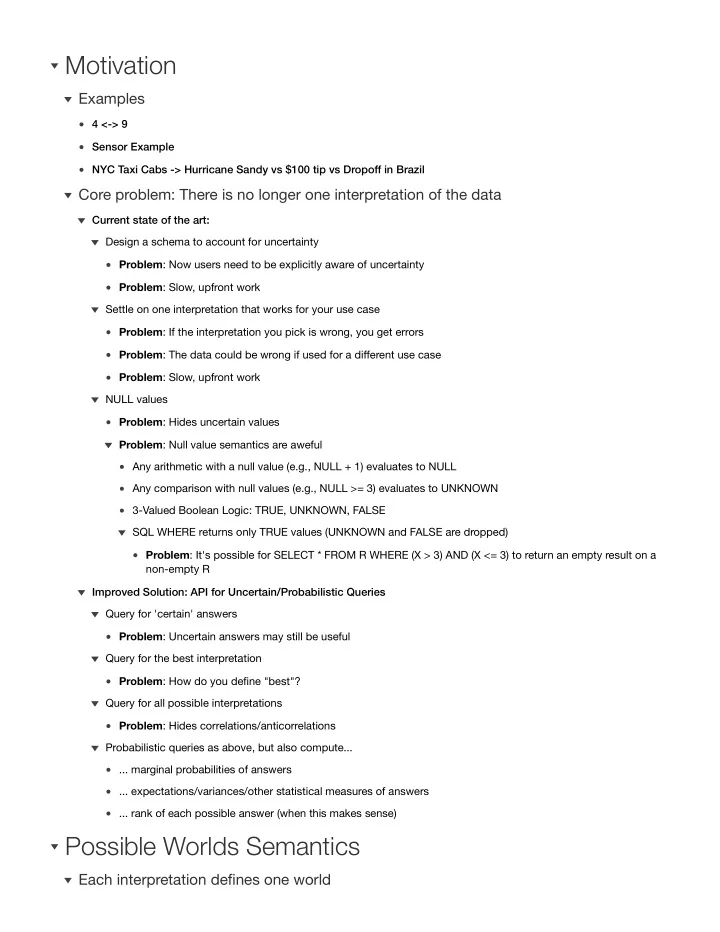

Motivation Examples 4 <-> 9 Sensor Example NYC Taxi Cabs -> Hurricane Sandy vs $100 tip vs Dropoff in Brazil Core problem: There is no longer one interpretation of the data Current state of the art: Design a schema to account for uncertainty Problem : Now users need to be explicitly aware of uncertainty Problem : Slow, upfront work Settle on one interpretation that works for your use case Problem : If the interpretation you pick is wrong, you get errors Problem : The data could be wrong if used for a di ff erent use case Problem : Slow, upfront work NULL values Problem : Hides uncertain values Problem : Null value semantics are aweful Any arithmetic with a null value (e.g., NULL + 1) evaluates to NULL Any comparison with null values (e.g., NULL >= 3) evaluates to UNKNOWN 3-Valued Boolean Logic: TRUE, UNKNOWN, FALSE SQL WHERE returns only TRUE values (UNKNOWN and FALSE are dropped) Problem : It's possible for SELECT * FROM R WHERE (X > 3) AND (X <= 3) to return an empty result on a non-empty R Improved Solution: API for Uncertain/Probabilistic Queries Query for 'certain' answers Problem : Uncertain answers may still be useful Query for the best interpretation Problem : How do you define "best"? Query for all possible interpretations Problem : Hides correlations/anticorrelations Probabilistic queries as above, but also compute... ... marginal probabilities of answers ... expectations/variances/other statistical measures of answers ... rank of each possible answer (when this makes sense) Possible Worlds Semantics Each interpretation defines one world
An uncertain database is actually a set of databases, each representing one interpretation or "possible world" For now, all of these databases share the same schema. How do we define query semantics for a set of possible worlds: Queries should return a set of "possible answers" Naive idea: Run the query independently in each possible world Problem : Ine ffi cient. Can be lots of possible worlds. Problem : Could be impossible. Can be an infinite number of possible worlds But ... This still defines a self-consistent set of rules for evaluating queries on uncertain data Representation Requirements Closed There exists a Q' such that Q'(Rep(D)) == Rep(Q(D)) Meaningful The representation has to be useful... although for what depends on the application ... or better still B ij ective Ideally, it would be nice to be able to reconstruct all possible worlds from the representation. Factorization attempts Three types of uncorrelated uncertainty: Row-level: A row is present precisely half of all possible worlds --- and other than the row, everything else is identical between the two halves Attribute-level: There are N copies of all worlds where a row is present, di ff ering only in a single attribute which takes N distinct values --- N may be infinity Open-world: There are an infinite number of worlds with an unbounded number of rows in them, and we have rules for generating more rows Adding correlations Create an integer "world-id" Define a function that maps the world-id to a concrete database (or relation) instance) ... so how do we define these functions? V-Tables Null Value Semantics on Steroids 'Label' each Null. i.e., Nulls become Variables A V-table is effectively a Function: A possible world is defined by a mapping from labels to nulls Externally provided ruleset defines what's allowed to be in a labeled null Proving Closure for V-Tables Exercise for the reader Works for π , x, U, but not σ
... because there's no way to represent a row that "might" be in the result set Works under both set and bag semantics ... although the representation may have some duplicate rows that need to be removed C-Tables V-Tables with an additional "Condition" column Each table gets an added column containing a boolean expression that may reference label symbols When evaluating the V-Table as a Function, plug label values into the boolean expression Boolean expressions that evaluate to false are not present in that specific possible world. Proving Closure for C-Tables Also an exercise for the reader Works for π , x, U, σ , δ but not generalized π or Ɣ ... well, not entirely true. It works if π and Ɣ are allowed to create new variable symbols and constrain their values based on the values of other symbols ... which means π and Ɣ e ff ectively have side e ff ects Works for both bag and set representations, although as before there may be duplicates Simplified C-Tables (U-Relations) Remove Support for Labeled Nulls Create one row for each possible value and add to the condition column `AND [label] = [value]` ... only works if you have a finite, discrete set of possible values Worldset-Decompositions Store the U-Relation column-store style. Generalized C-Tables Allow the creation of new variable symbols defined by formulas e.g., { X + 2*Y } Closed over SPJUA+Distinct ... although for aggregates/distinct the representation can get very very very large Weaker Models OR-SET encoding Label tuples that are not in at least one possible world with a ? (this alone is generally called Tuple-independent) Use sets of allowable values instead of attributes Can not capture correlations X-Tuples Group tuples into sets of mutually exclusive possibilities (can be combined w/ OR-SET) Queries on C-Tables
Basic query types Certain Answers Answers in *all* possible worlds Possible Answers Answers in *any* possible world Limitations Expensive to compute either of these Possible produces too much, while certain produces too little. Tradeo ff Points Best Guess (Maximal Prior) - Pick a (most likely) world and evaluate the query in it Maximal Posterior - Use probabilities (discussed next class) to pick result rows exceeding a given threshold probability. Sampling - Pick a set of possible worlds at random and evaluate the query in each of those (more discussed soon)
Recommend
More recommend